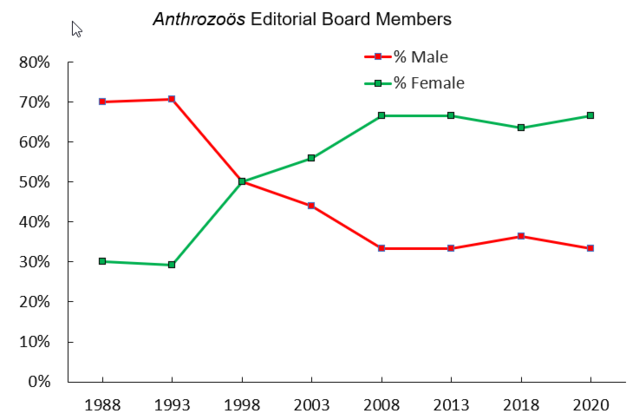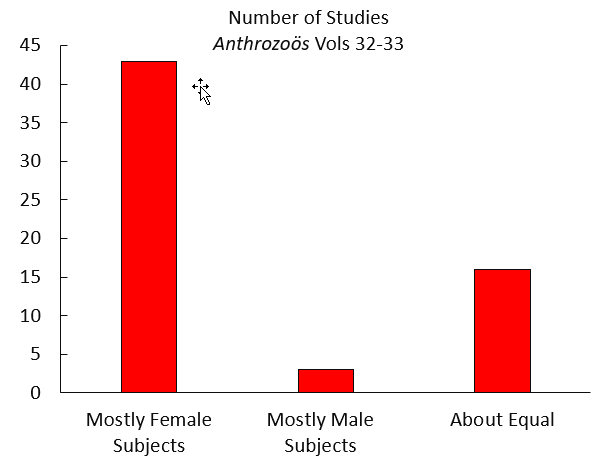Gender
Women Dominate Research on the Human-Animal Bond
A lack of male subjects is a big problem in human-animal interaction studies.
Posted May 24, 2021 Reviewed by Kaja Perina
Key points
- More women than men are drawn to professions that involve the care of animals.
- In recent years. female researchers have come to dominate the study of human-animal relationships.
- While women are underrepresented as subjects in medical research, there are too few male participants in studies of the human-animal bond.
- The lack of male participants compromises the validity of many studies of human-animal relationships.

Today, women are drawn to professions related to the care and welfare of animals. Take veterinary medicine. In 1960, veterinary medicine was essentially an all-male profession—fewer than 2% of vets in the United States were women. This skewed sex ratio began to reverse in the 1970s. Today, 60% of veterinarians in the United States and 80% of vet school students are women.
In recent years, women have flocked to fields like veterinary medicine, animal shelter work, and professional dog training. But why? I ran this question by Diana Fleishman, an evolutionary psychologist. She believes these professions align with a natural feminine propensity to care for members of other species. She explained to me in an e-mail: From my perspective, the culture has changed in ways that women were more likely to go into the workforce than to stay at home and be homemakers. And they chose careers that were interesting to them. Animal issues have very frequently been entangled with feminist politics because women have an interest in both areas. As women came to be equally or over-represented in fields like biology, psychology, and sociology starting in the 80s, they also came to be over-represented in research on animal issues.
The Impact of Women on Research on the Human-Animal Bond
Women investigators dominate the study of human-animal interactions. Indeed, it was a 1980 study by a woman, Erika Friedmann, that kicked off the field 40 years ago. Her doctoral research was on the role of social support on heart attack survival rates. She asked ninety-six patients in a coronary care unit to complete a survey concerning their socioeconomic status, living situation, and their connections with their friends and family. She also threw in an item asking whether they lived with a pet.
Twelve months later, she tracked down the participants to see how they were doing. To her surprise, owning a pet made a big difference in survival rates. While 28% of the non-pet owners had died by the end of the year, only 6% of the pet owners were dead. Excited by these results, Friedmann presented them at a meeting of the American Heart Association. Soon, she was reading about herself in Reader’s Digest and Time. It was a good way to start a career.
Erika went on to become one of the founders of the International Society for Anthrozoology (ISAZ) -- the main research organization for people who investigate human-animal relationships, and she was the organization’s first president. Forty years later, Friedmann remains a leader in the field, and in 2019 she received the society’s Distinguished Anthrozoologist Award.
Erika was the first of a long line of women who were instrumental in the development of the science of the human-animal bond. For example, in the early 1990s, Karen Allen of the University of Buffalo conducted a series of pioneering experiments that demonstrated the positive impact of interacting with pets on heart rate, blood pressure, and stress. And in 1983, Lynette Hart established the Center for Animals and Society at the University of California at Davis. It was one of the first research centers devoted to the study of the roles of animals in human lives.
In recent years, women have become even more dominant in human-animal interaction research. Take, for example, the gender composition of the editorial board of Anthrozoös, the first and arguably most influential journal in the field. When it was founded in 1988, 80% of the

Anthrozoös editorial board members were men and 20% were women. Now, the gender disparity is reversed; female board members outnumber males by four to one. Further, female researchers make up 80% of members of the International Society for Anthrozoology. And 15 of the 18 members of the society’s board of directors, including all of the officers, are women. Women also rule when it comes to publishing research on human interactions. Of the 136 authors of papers published in the six issues of the journal Anthrozoös in 2019, 79% were women. And a new crop of

first-rate female researchers has entered the field over the last decade. For example, the recipients of the ISAZ Early Career Award -- Maggie O’Haire, Carrie Westgarth, and Karin Hediger – have all been women.
The Gender Imbalance Among Research Subjects Is A Big Problem
Gender disparities are common in science – even among research subjects. For example, there is increasing concern that most studies on cancer and strokes include too few women. Even most biomedical studies on mice use male subjects.
The study of human-animal interactions has the opposite problem. For example, a 2020 study of owners’ “parenting styles” towards dogs included 470 women and 42 men. And 119 women and 6 men volunteers participated in a study of the problems confronted by pet owners evacuating with their companion animals in the face of a hurricane. A recent study of the relationships between people with cancer and their pets was really a study of the relationships between women with cancer and their pets: every one of the participants was female.
Psychologists have become concerned that the vast majority of their research is based on the study of people who are “WEIRD” - that is, from Western, Educated, Industrialized, Rich, and Democratic countries. The anthropologist Jeremy Koster is concerned that modern canine science is based exclusively on dogs he refers to as “NATIVE” – Neutered, Alimented, Trained, Isolated, Vaccinated and Engineered. (Alimented means they are fed by humans.) He points out that personal pets in developed countries are not representative of the 85% of dogs on Earth who mostly run free, decide who they want to mate with, and are never confined by a leash.
Are the results of investigations of the human-animal bond seriously compromised by a lack of male research participants? Is it true that most of these studies have a disproportionate number of female subjects?
To get a handle on this question, I looked at the sex ratios of research subjects in papers published in the 12 issues of the journal Anthrozoös published in 2019 and 2020 (Volumes 32 and 33). These included 64 individual studies. (Several papers included two separate studies, and I did not include a couple of studies because they involved children or data taken from existing large epidemiological surveys.)
A total of 23,149 subjects participated in the studies. Of these, 18,102 were women and 6,047 were men – a female to male sex ratio of three to one. (Only a handful of subjects indicated “other” as their gender.) I broke the 64 studies into three categories. The Mostly Women category included studies in which 61% or more of the subjects were women. The Mostly Men category contained studies in which 61% or more were men, and the About Equal category included studies in which between 40% and 60% were women. This graph shows the results.
Forty-three of the studies included mostly female participants compared to only three of the studies that contained mostly men. Further, the three “mostly men” studies involved special populations – veterans, people with spinal cord injuries, and people with autism. Studies that involved mostly women were nearly three times more common than studies that had roughly equal numbers of males and females. They were 10 times more common than studies in the "mostly male" category.

Many of the papers downplayed the gender disparity among the subjects. Two studies, for example, did not include any information on the sex of the participants. Others only mentioned in passing that there were hardly any males in the sample. On the other hand, several of the research teams specifically recruited equal numbers of men and women. And one study was conducted with equal numbers of men and women in order to replicate the results of an initial study that included 85% women.
Are There Solutions to the Lack of Male Research Participants?
Women researchers were instrumental in the study of human-animal interactions as a legitimate field of research, and it appears that at least 80% of the active scholars in the field are now women. This is not a problem. But skewed sex ratios among research subjects. That’s why the National Institutes of Health now insists that women and minorities be included in NIH-funded studies.
Here are a couple of ideas that might help alleviate this situation in anthrozoology.
- Researchers should actively recruit roughly equal numbers of male and female research participants.
- Surveys should include non-traditional gender categories such as “non-binary” or “other.”
- If a study winds up with a large number of women and a small number of men, researchers might consider dropping all of the men and making the study about the relationships between women and animals. (This rule should be specified when designing a study. Otherwise, the researchers will be guilty of “p-hacking” -- jimmying their results.)
- As canine researcher Mia Cobb reminded me, one way to get a balanced mix of men and women in studies is by using a prescreened paid survey panel. However, this can be expensive.
- Authors of research papers should make the gender breakdown of subjects in their studies clear from the outset rather than burying the information deep in the text.
References
Friedmann, E., Katcher, A. H., Lynch, J. J., & Thomas, S. A. (1980). Animal companions and one-year survival of patients after discharge from a coronary care unit. Public health reports, 95(4), 307.
Koster, J. (2021). Most Dogs Are Not NATIVE Dogs. Integrative and Comparative Biology.
Tsivgoulis, G., Katsanos, A. H., & Caso, V. (2017). Under-representation of women in stroke randomized controlled trials: inadvertent selection bias leading to suboptimal conclusions. Therapeutic advances in neurological disorders, 10(5), 241-244.




